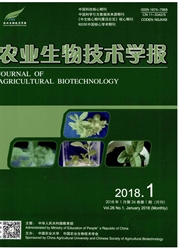

 中文摘要:
中文摘要:
γ-Gliadins are an important component of wheat seed storage proteins.Four novelγ-gliadin genes(Gli-ng1 to Gli-ng4)were cloned from wheat(Triticum aestivum)and Aegilops species.The novelγ-gliadins were much smaller in molecular size when compared to the typicalγ-gliadins,which was caused by deletion of the non-repetitive domain,glutamine-rich region,3′part of the repetitive domain,and 5′part of the C-terminal,possibly due to illegitimate recombination between the repetitive domain and the C-terminal.As a result,Gli-ng1 and Gli-ng4 only contained two and three cysteine residues,respectively.Gli-ng1,as the representative of novelγ-gliadin genes,has been sub-cloned into an Escherichia coli expression system.SDSPAGE indicated that the both cysteine residues of Gli-ng1 could participate in the formation of intermolecular disulphide bonds in vitro.Successful cloning of Gli-ng1 from seed cDNA of T.aestivum cv.Chinese Spring suggested that these novelγ-gliadin genes were normally transcribed during the development of seeds.Phylogenic analysis indicated that the four novelγ-gliadin genes had a closer relationship with those from the B(S)genome of wheat.
 英文摘要:
英文摘要:
γ-Gliadins are an important component of wheat seed storage proteins. Four novel γ-gliadin genes (Gli-ngl to Gli-ng4) were cloned from wheat (Triticum aestivum) and Aegilops species. The novel γ-gliadins were much smaller in molecular size when compared to the typical γ-gliadins, which was caused by deletion of the non-repetitive domain, glutamine-rich region, 3" part of the repetitive domain, and 5' part of the C-terminal, possibly due to illegitimate recombination between the repetitive domain and the C-terminal. As a result, Gli-ngl and Gli-ng4 only contained two and three cysteine residues, respectively. Gli-ngl, as the representative of novel γ-gliadin genes, has been sub-cloned into an Escherichia coli expression system. SDS- PAGE indicated that the both cysteine residues of Gli-ngl could participate in the formation of intermolecular disulphide bonds in vitro. Successful cloning of Gli-ngl from seed cDNA of T. aestivum cv. Chinese Spring suggested that these novel γ-gliadin genes were normally transcribed during the development of seeds. Phylogenic analysis indicated that the four novel γ-gliadin genes had a closer relationship with those from the B (S) genome of wheat.
 同期刊论文项目
同期刊论文项目
 同项目期刊论文
同项目期刊论文
 Aegilops tauschii single nucleotide polymorphisms shed light on the origins of wheat D-genome geneti
Aegilops tauschii single nucleotide polymorphisms shed light on the origins of wheat D-genome geneti 期刊信息
期刊信息
